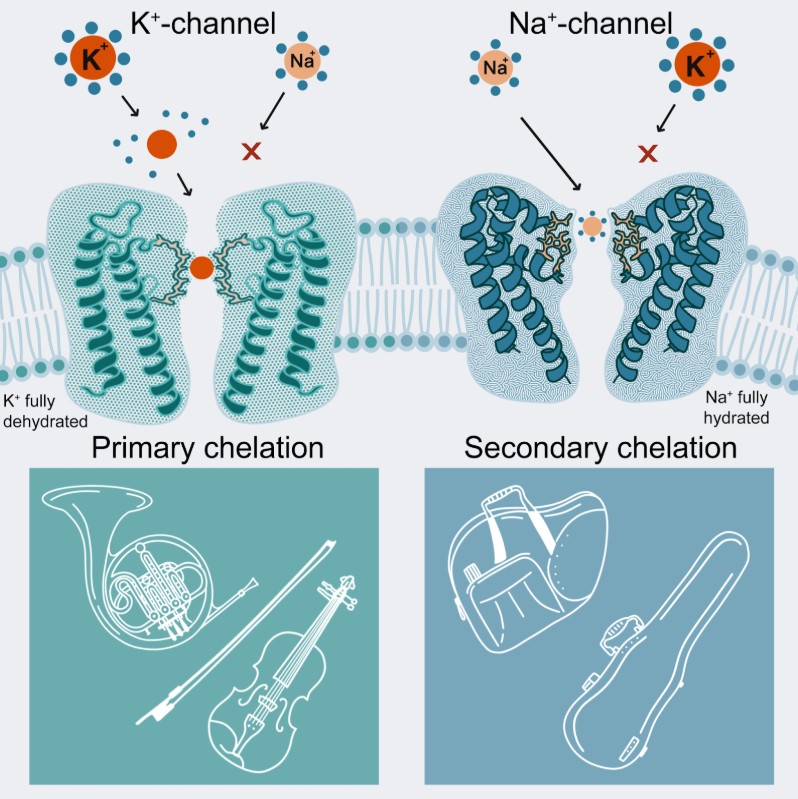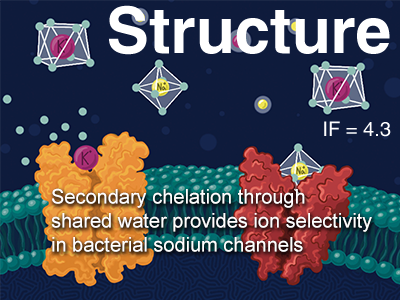Press-room / news / Science news /
«Secondary Chelation» Mechanism is Proposed to Explain the Selectivity of Bacterial Sodium Channels
Sodium channels play an important role in nature — for example, they determine the excitability of the nervous system and muscles. Their selective conductivity has been intensively studied for many decades, but its physicochemical basis is still unclear. In a new theoretical paper, scientists from the Institute of Bioorganic Chemistry have proposed the so-called “secondary chelation” mechanism, in which the spatial organization of water molecules in the hydration shell of the ion plays a key role. The selectivity filter of a bacterial sodium channel is designed to optimally interact with the hydration shell of Na+, while the shell of K+ is forced to “shrink”, which prevents its passage. The work was published in the journal Structure and was also awarded an illustration on the cover of the issue.
Molecular dynamics simulations showed that the selectivity filter of the bacterial sodium channel NavMs is organized in such a way as to optimally interact with the hydration shell of Na+ in an energetically favorable octahedral stereometry. Thus, the selectivity filter allows Na+ ions to pass through the channel unimpeded. The hydration shell of the second most abundant cation, i.e. K+, has the shape of a square antiprism, and it is forced to “shrink” in the selectivity filter. This leads to the emergence of an energy barrier to the passage of K+ through the channel, which appears to be the basis of the selectivity.
The “secondary chelation” mechanism in bacterial sodium channels differs from the mechanism of potassium channel selectivity discovered by Nobel laureate Roderick MacKinnon and colleagues back in 1998, which by analogy can be called “primary chelation” (or simply chelation). The polar groups of the potassium channel selectivity filter (carbonyls of the protein backbone) are spatially oriented in such a way as to replace water molecules in the hydration shell of K+, but not Na+. Our previous work was devoted to studying this principle in detail: “On the Selectivity of K+-Channels: How Do Proteins Know About the Square Antiprism?”
The two mechanisms by which ions are recognized in ion channels: direct (“primary chelation”, as in potassium channels) and through the hydration shell (“secondary chelation”, as in bacterial sodium channels) are analogous to how we recognize a musical instrument: by its appearance, or by looking at the shape of the case in which it is stored and carried (see figure).

Figure. Left: “primary chelation” of ions in potassium channels. The selectivity filter recognizes the ion type directly by replacing the hydration shell in a way that is favorable for K+. We can also directly distinguish a violin from a French horn by their appearance. Right: “secondary chelation” of ions in bacterial sodium channels. The selectivity filter recognizes the ion type by creating an environment that is favorable for the Na+ hydration shell. Similarly, we can recognize a musical instrument by the shape of its case. This illustration (graphical abstract) and the image on the cover of the Structure issue were drawn by Anastasiia Samoukina.
august 8


